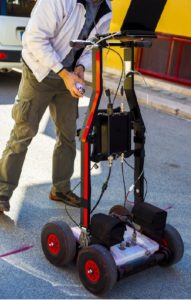
Ground-penetrating radar (GPR) is a reliable method for scanning that ensures the safety of everyone on a construction site while conducting any concrete cutting or coring. That said, many people have misunderstandings about what ground-penetrating radar is capable of doing. We’re here to clear up any confusion people may have. Read on to find out about the misconceptions regarding ground-penetrating radar.
If I Buy the Equipment, It Means I Can Scan On My Own
Setting up your ground penetrating radar equipment is a simple matter, but interpreting the data is much more complicated. Some people believe that GPR will show crisp, clear images of what’s inside the concrete. In reality, you’ll see a screen that shows nothing but black and white, similar to TV static. Anytime an object is detected by the antenna, a hyperbola will be reflected onto the screen. GPR analysts require a great deal of training to understand and interpret this information and to determine what objects are being shown on the screen.
Ground Penetrating Radar Can Work On Any Surface
The success of concrete scanning is heavily influenced by the moisture of the concrete. Moisture heightens conductivity, which results in signals being sent right back. This makes it harder to get acceptable data readings. If the concrete being scanned is no more than three months old, it’s more likely to have high moisture, so you’re better off waiting to conduct concrete scanning until the concrete has had additional time for curing. GPR also has a tough time on granite floors, marble, and insulation.
Ground Penetrating Radar Can Scan Objects At Any Depth You Need
GPR equipment has its limits, and it can only scan objects that are up to 20 inches beneath the surface. If the concrete can be scanned on both sides, it can help analysts scan concrete slabs of greater thickness.
Ground Penetrating Radar Has 100% Precision
Even though GPR is viewed as one of the best variants of non-destructive testing available, it’s not without its flaws. It can have its accuracy influenced by several variables, such as pan decking, rebar, and wire mesh.
Concrete Visions Will Get The Job Done Right
Concrete Visions has been working with clients for over 25 years. Our G&M Services installers are certified with the industry’s major firestop product manufacturers. As part of our firestop service, we can assess abnormal field conditions and, with the manufacturer’s technical support assistance, provide engineering judgments in a timely fashion to comply with contract specifications. Our Field Mechanics undergo ongoing training, including mandatory monthly safety meetings, weekly Toolbox Talks where safety and equipment information is shred, and trainings on safe work standards and safety best practices.
